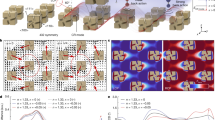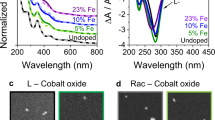Abstract
Stereochemistry has an essential role in organic synthesis, biological catalysis and physical processes. In situ chirality identification and asymmetric synthesis are non-trivial tasks, especially for single-molecule systems. However, going beyond the chiral characterization of a large number of molecules (which inevitably leads to ensemble averaging) is crucial for elucidating the different properties induced by the chiral nature of the molecules. Here we report direct monitoring of chirality variations during a Michael addition followed by proton transfer and keto–enol tautomerism in a single molecule. Taking advantage of the chirality-induced spin selectivity effect, continuous current measurements through a single-molecule junction revealed in situ chirality variations during the reaction. Chirality identification at a high sensitivity level provides a promising tool for the study of symmetry-breaking reactions and sheds light on the origin of the chirality-induced spin selectivity effect itself.

This is a preview of subscription content, access via your institution
Access options
Access Nature and 54 other Nature Portfolio journals
Get Nature+, our best-value online-access subscription
$29.99 / 30 days
cancel any time
Subscribe to this journal
Receive 12 print issues and online access
$259.00 per year
only $21.58 per issue
Buy this article
- Purchase on Springer Link
- Instant access to full article PDF
Prices may be subject to local taxes which are calculated during checkout




Similar content being viewed by others
Data availability
Additional discussions and data supporting this article are available in the Supplementary Information. Source data are provided with this paper.
References
Dalko, P. I. & Moisan, L. In the golden age of organocatalysis. Angew. Chem. Int. Ed. 43, 5138–5175 (2004).
Bornscheuer, U. T. et al. Engineering the third wave of biocatalysis. Nature 485, 185–194 (2012).
Hsieh, D. et al. Observation of unconventional quantum spin textures in topological insulators. Science 323, 919–922 (2009).
Hendry, E. et al. Ultrasensitive detection and characterization of biomolecules using superchiral fields. Nat. Nanotechnol. 5, 783–787 (2010).
Tu, H.-F., Yang, P., Lin, Z.-H., Zheng, C. & You, S.-L. Time-dependent enantiodivergent synthesis via sequential kinetic resolution. Nat. Chem. 12, 838–844 (2020).
Yeom, J. et al. Chiromagnetic nanoparticles and gels. Science 359, 309–314 (2018).
Tang, Y. & Cohen Adam, E. Enhanced enantioselectivity in excitation of chiral molecules by superchiral light. Science 332, 333–336 (2011).
Banerjee-Ghosh, K. et al. Separation of enantiomers by their enantiospecific interaction with achiral magnetic substrates. Science 360, 1331–1334 (2018).
Kumar, J. et al. Detection of amyloid fibrils in Parkinson’s disease using plasmonic chirality. Proc. Natl Acad. Sci. USA 115, 3225–3230 (2018).
Steendam, R. R. E. et al. Emergence of single-molecular chirality from achiral reactants. Nat. Commun. 5, 5543 (2014).
Gohler, B. et al. Spin selectivity in electron transmission through self-assembled monolayers of double-stranded DNA. Science 331, 894–897 (2011).
Naaman, R., Paltiel, Y. & Waldeck, D. H. Chiral molecules and the electron spin. Nat. Rev. Chem. 3, 250–260 (2019).
Kim, Y. H. et al. Chiral-induced spin selectivity enables a room-temperature spin light-emitting diode. Science 371, 1129–1133 (2021).
Naaman, R., Paltiel, Y. & Waldeck, D. H. Chiral molecules and the spin selectivity effect. J. Phys. Chem. Lett. 11, 3660–3666 (2020).
Aragones, A. C. et al. Measuring the spin-polarization power of a single chiral molecule. Small 13, 1602519 (2017).
Naaman, R. & Waldeck, D. H. Spintronics and chirality: spin selectivity in electron transport through chiral molecules. Annu. Rev. Phys. Chem. 66, 263–281 (2015).
Al-Bustami, H. et al. Single nanoparticle magnetic spin memristor. Small 14, 1801249 (2018).
Brandt, J. R., Salerno, F. & Fuchter, M. J. The added value of small-molecule chirality in technological applications. Nat. Rev. Chem. 1, 0045 (2017).
Michaeli, K., Kantor-Uriel, N., Naaman, R. & Waldeck, D. H. The electron’s spin and molecular chirality—how are they related and how do they affect life processes? Chem. Soc. Rev. 45, 6478–6487 (2016).
Alwan, S. & Dubi, Y. Spinterface origin for the chirality-induced spin-selectivity effect. J. Am. Chem. Soc. 143, 14235–14241 (2021).
Ghazaryan, A., Paltiel, Y. & Lemeshko, M. Analytic model of chiral-induced spin selectivity. J. Phys. Chem. C 124, 11716–11721 (2020).
Qi, D., Kenaan, A., Cui, D. & Song, J. Novel insights into the selection to electron’s spin of chiral structure. Nano Energy 52, 142–152 (2018).
Dubi, Y. Spinterface chirality-induced spin selectivity effect in bio-molecules. Chem. Sci. 13, 10878–10883 (2022).
Evers, F., Korytár, R., Tewari, S. & van Ruitenbeek, J. M. Advances and challenges in single-molecule electron transport. Rev. Mod. Phys. 92, 035001 (2020).
Xin, N. et al. Concepts in the design and engineering of single-molecule electronic devices. Nat. Rev. Phys. 1, 211–230 (2019).
Park, J. et al. Coulomb blockade and the Kondo effect in single-atom transistors. Nature 417, 722–725 (2002).
Bai, J. et al. Anti-resonance features of destructive quantum interference in single-molecule thiophene junctions achieved by electrochemical gating. Nat. Mater. 18, 364–369 (2019).
Winkelmann, C. B., Roch, N., Wernsdorfer, W., Bouchiat, V. & Balestro, F. Superconductivity in a single-C60 transistor. Nat. Phys. 5, 876–879 (2009).
Kim, W. Y. & Kim, K. S. Tuning molecular orbitals in molecular electronics and spintronics. Acc. Chem. Res. 43, 111–120 (2010).
Waldrop, M. M. The chips are down for Moore’s law. Nat. News 530, 144–147 (2016).
Li, Y., Yang, C. & Guo, X. Single-molecule electrical detection: a promising route toward the fundamental limits of chemistry and life science. Acc. Chem. Res. 53, 159–169 (2020).
Yang, C. et al. Single-molecule electrical spectroscopy of organocatalysis. Matter 4, 2874–2885 (2021).
Yang, C. et al. Unveiling the full reaction path of the Suzuki–Miyaura cross-coupling in a single-molecule junction. Nat. Nanotechnol. 16, 1214–1223 (2021).
Chen, H. et al. Electron-catalyzed dehydrogenation in a single-molecule junction. J. Am. Chem. Soc. 143, 8476–8487 (2021).
Aragones, A. C. et al. Electrostatic catalysis of a Diels–Alder reaction. Nature 531, 88–91 (2016).
Huang, G. & Li, X. Applications of Michael addition reaction in organic synthesis. Curr. Org. Synth. 14, 568–571 (2017).
Sibi, P. M. & Manyem, S. Enantioselective conjugate additions. Tetrahedron 56, 8033–8061 (2000).
Yang, C. et al. Electric field–catalyzed single-molecule Diels–Alder reaction dynamics. Sci. Adv. 7, eabf0689 (2021).
Gómez-Torres, E., Alonso, D. A., Gómez-Bengoa, E. & Nájera, C. Enantioselective synthesis of succinimides by Michael addition of 1,3-dicarbonyl compounds to maleimides catalyzed by a chiral bis(2-aminobenzimidazole) organocatalyst. Eur. J. Org. Chem. 2013, 1434–1440 (2013).
Gersten, J., Kaasbjerg, K. & Nitzan, A. Induced spin filtering in electron transmission through chiral molecular layers adsorbed on metals with strong spin–orbit coupling. J. Chem. Phys. 139, 114111 (2013).
Xie, Z. et al. Spin specific electron conduction through DNA oligomers. Nano Lett. 11, 4652–4655 (2011).
Kondou, K. et al. Chirality-induced magnetoresistance due to thermally driven spin polarization. J. Am. Chem. Soc. 144, 7302–7307 (2022).
Das, T. K., Tassinari, F., Naaman, R. & Fransson, J. Temperature-dependent chiral-induced spin selectivity effect: experiments and theory. J. Phys. Chem. C 126, 3257–3264 (2022).
Jeong, H., Li, H. B., Domulevicz, L. & Hihath, J. An on-chip break junction system for combined single-molecule conductance and Raman spectroscopies. Adv. Funct. Mater. 30, 2000615 (2020).
Badala Viswanatha, C. et al. Vectorial electron spin filtering by an all-chiral metal–molecule heterostructure. J. Phys. Chem. Lett. 13, 6244–6249 (2022).
Acknowledgements
We acknowledge primary financial support from the National Key R&D Program of China (2022YFE0128700, 2017YFA0204901 and 2021YFA1200101), National Natural Science Foundation of China (22150013, 22173050, 21727806 and 21933001), Tencent Foundation (through the Xplorer Prize), Natural Science Foundation of Beijing (2222009) and Frontiers Science Center for New Organic Matter at Nankai University (63181206). Y.D. acknowledges support from the Israel Science Foundation (1360/17). S.Z. and Z.L. appreciate support from the High-Performance Computing Platform of the Center for Life Science (Peking University) and High-Performance Computing Platform of Peking University.
Author information
Authors and Affiliations
Contributions
X.G., Y.D. and K.N.H. conceived of and designed the experiments. C.Y., Y.G. and C.J. fabricated the devices and performed the device measurements. Y.D., Y.L., S.Z. and Z.L. built and analysed the theoretical model and performed the quantum transport calculation. X.G., Y.D., K.N.H. and C.Y. analysed the data and wrote the paper. All authors discussed the results and commented on the manuscript.
Corresponding authors
Ethics declarations
Competing interests
The authors declare no competing interests.
Peer review
Peer review information
Nature Chemistry thanks Ismael Diez Perez, Kun Wang and the other, anonymous, reviewer(s) for their contribution to the peer review of this work.
Additional information
Publisher’s note Springer Nature remains neutral with regard to jurisdictional claims in published maps and institutional affiliations.
Supplementary information
Supplementary Information
Supplementary methods and Figs. 1–49.
Source data
Source Data Fig. 2
I−t curves, corresponding histogram and potential energy surface and statistical source data.
Source Data Fig. 3
Experimental and simulated I–V curves and CISS polarization.
Source Data Fig. 4
I–t curves, corresponding histogram and potential energy surface.
Rights and permissions
Springer Nature or its licensor (e.g. a society or other partner) holds exclusive rights to this article under a publishing agreement with the author(s) or other rightsholder(s); author self-archiving of the accepted manuscript version of this article is solely governed by the terms of such publishing agreement and applicable law.
About this article
Cite this article
Yang, C., Li, Y., Zhou, S. et al. Real-time monitoring of reaction stereochemistry through single-molecule observations of chirality-induced spin selectivity. Nat. Chem. 15, 972–979 (2023). https://doi.org/10.1038/s41557-023-01212-2
Received:
Accepted:
Published:
Issue Date:
DOI: https://doi.org/10.1038/s41557-023-01212-2
This article is cited by
-
Real-time in-situ monitoring of chiral changes during a reaction at single-molecule level
Science China Chemistry (2024)
-
Chirality-induced spin selectivity enables real-time monitoring of a chemical reaction
Nature Reviews Materials (2023)
-
Interplay of structural chirality, electron spin and topological orbital in chiral molecular spin valves
Nature Communications (2023)
-
Detecting the single chiral molecule during the reaction
Science China Materials (2023)
-
Precise Detection, Control and Synthesis of Chiral Compounds at Single-Molecule Resolution
Nano-Micro Letters (2023)



